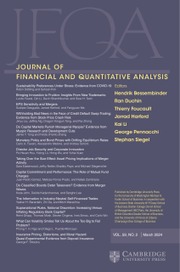No CrossRef data available.
Article contents
Valuation and Long-Term Growth Expectations
Published online by Cambridge University Press: 07 April 2025
Abstract
Long-term growth expectations are central to investment analysis and corporate valuation. Despite a dominant effect on firm value, the academic literature and practitioner conventions provide little guidance on determining this long-term growth rate. This article takes a step in addressing this gap: we estimate the relationship between long-term growth and an extensive selection of firm, industry, and market characteristics. Market prices do not seem to fully capture long-term growth information. Cross sectional tests yield substantial positive abnormal returns for firms with high expected long-term growth.
- Type
- Research Article
- Information
- Creative Commons
- This is an Open Access article, distributed under the terms of the Creative Commons Attribution licence (http://creativecommons.org/licenses/by/4.0), which permits unrestricted re-use, distribution and reproduction, provided the original article is properly cited.
- Copyright
- © The Author(s), 2025. Published by Cambridge University Press on behalf of the Michael G. Foster School of Business, University of Washington
Footnotes
We thank Matthias Molnar, Haviland Sheldahl-Thomason, and Xuan Su for their excellent research assistance. The article greatly benefited from the valuable suggestions of two anonymous referees and Mara Faccio (the editor), as well as Anne Anderson (discussant), Nick Bollen, Gjergji Cici, Alois Geyer, Mohammad Ghaderi, Ted Juhl, Christian Laux, Craig Lewis, J Li (discussant), Shaobo Li, Neal Stoughton, Avanidhar Subrahmanyam, Mihail Velikov, Bob Whaley, and the participants at the Financial Management Association USA conference, Northern Finance Association conference, Silicon Prairie Finance conference, Johns Hopkins University, University of St. Gallen, Spängler IQAM, University of Maryland, Vanderbilt, and the Vienna Graduate School of Finance (VGSF) for helpful comments and discussions. Any remaining errors are our own.


